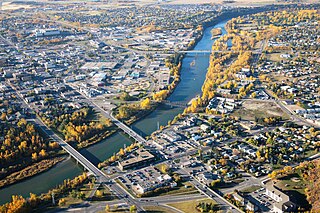
Red Deer is a city in Alberta, Canada, located midway on the Calgary–Edmonton Corridor. Red Deer serves central Alberta, and its key industries include health care, retail trade, construction, oil and gas, hospitality, manufacturing and education. It is surrounded by Red Deer County and borders on Lacombe County. The city is in aspen parkland, a region of rolling hills, alongside the Red Deer River.

The University of Alberta is a public research university located in Edmonton, Alberta, Canada. It was founded in 1908 by Alexander Cameron Rutherford, the first premier of Alberta, and Henry Marshall Tory, the university's first president. It was enabled through the Post-secondary Learning Act. The university is considered a "comprehensive academic and research university" (CARU), which means that it offers a range of academic and professional programs that generally lead to undergraduate and graduate level credentials.

St. Albert is a city in Alberta, Canada, located on the Sturgeon River, northwest of the City of Edmonton, the provincial capital. It was originally settled as a Métis community, and is now the second-largest city in the Edmonton Metropolitan Region. St. Albert first received its town status in 1904 and was reached by the Canadian Northern Railway in 1906. Originally separated from Edmonton by several miles of farmland, the 1980s expansion of Edmonton's city limits placed St. Albert immediately adjacent to the larger city on St. Albert's southern and eastern sides.

Wetaskiwin is a city in the province of Alberta, Canada. The city is located 70 kilometres (43 mi) south of the provincial capital of Edmonton. The city name comes from the Cree word wītaskiwinihk, meaning "the hills where peace was made".
The Southern Alberta Institute of Technology (SAIT) is a polytechnic institute in Calgary, Alberta, Canada. SAIT offers more than 110 career programs in technology, trades and business. Established in 1916, it is Calgary's second oldest post-secondary institution and Canada's first publicly funded technical institute.
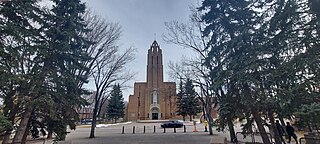
St. Mary's Cathedral in Calgary, Alberta, Canada is a Roman Catholic cathedral and the seat of the Diocese of Calgary. The building's full name is The Cathedral of the Immaculate Conception of the Blessed Virgin Mary.
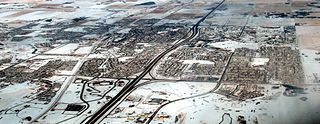
Airdrie is a city in Alberta, Canada, within the Calgary Region and the Calgary Metropolitan Area, It is located north of Calgary within the Calgary–Edmonton Corridor at the intersection of Queen Elizabeth II Highway and Highway 567.
Heritage Park Historical Village is a living history museum in Calgary, Alberta, Canada, on 127 acres (51 ha) of parkland on the banks of the Glenmore Reservoir, in the city's southwestern quadrant. The Historical Village part of the park is open 7 days a week (10-5) from the Canadian May long weekend through to the September Labour Day long weekend, and then weekends from Labour Day through to Canadian Thanksgiving weekend in mid October. Gasoline Alley Museum and the Railway Café are open year-round. As one of Canada's largest living history museums, it is one of the city's most visited tourist attractions. Exhibits span western Canadian history from the 1860s to the 1950s. Many of the buildings are historical and were transported to the park to be placed on display. Others are re-creations of actual buildings. Most of the structures are furnished and decorated with genuine artifacts. Staff dress in historic costume, and antique automobiles and horse-drawn vehicles service the site. Calgary Transit provides regular shuttle service from Heritage C-Train station. The park opened on July 1, 1964.

Bowness is a neighbourhood and former town in west Calgary, Alberta, Canada. The former town was amalgamated into the City of Calgary in 1964.

Calgary School District No. 19 or the Calgary Board of Education (CBE) is the public school board in Calgary, Alberta, Canada. As a public system, the CBE is required to accept any students who meet age and residency requirements, regardless of religion. Calgary Board of Education (CBE) was founded in 1885 as the Calgary Protestant Public School District No. 19.
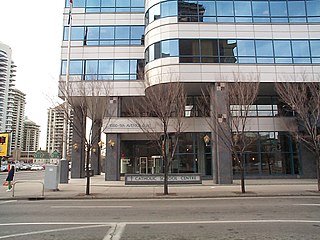
Calgary Roman Catholic Separate School District No. 1 or the Calgary Catholic School District (CCSD) is the Roman Catholic separate school board in Calgary, Alberta, Canada. It also serves the neighbouring communities of Airdrie, Chestermere, Cochrane and Rocky View County. The CSSD receives funding for students from the provincial government of Alberta.

The Mission district is an inner city neighbourhood of Calgary, Alberta, Canada, that originated as Notre Dame de la Paix, a Catholic mission and was for a time the incorporated Village of Rouleauville. Mission is bordered by 4th Street SW with restaurants and shops, and it hosts the Lilac Festival in June.
West Hillhurst is a northwest neighbourhood lying within the inner suburbs of Calgary, Alberta, Canada. The community, which is located west of Hillhurst, is bisected by Crowchild Trail. On the north, West Hillhurst is bordered by the communities of Hounsfield Heights/Briar Hill and St. Andrews Heights. Other boundaries are 18th Street W to the east, the Bow River to the south and 28th Street W to the west.
Midnapore is a community within the City of Calgary in the province of Alberta, Canada. It is bounded to the north and east by Fish Creek Provincial Park, to the south by Sun Valley Boulevard and to the west by Macleod Trail.

Bridgeland-Riverside, formerly known as Bridgeland and Germantown, is a neighbourhood in Calgary, Alberta, Canada, is located northeast of Downtown Calgary. It is bounded to the south by the Bow River, to the east by Deerfoot Trail, to the west by Edmonton Trail and to the north by the community of Renfrew.
Christ the Redeemer Catholic Separate Regional Division No. 3 or Christ the Redeemer Catholic Schools is a publicly funded Catholic school jurisdiction serving students in a number of communities across southern Alberta, Canada.
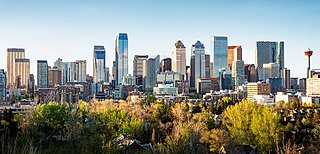
Calgary is the largest city in the Canadian province of Alberta. It is the largest metro area within the three prairie provinces. As of 2021, the city proper had a population of 1,306,784 and a metropolitan population of 1,680,000 making it the third-largest city and fifth-largest metropolitan area in Canada.
Grouard, also known as Grouard Mission, is a hamlet in northern Alberta within Big Lakes County. It was previously an incorporated municipality between 1909 and 1944.
Rocky View School Division No. 41 or Rocky View Schools (RVS) is the public school authority that serves students to the west, north and east of the City of Calgary in the province of Alberta.

Dr. E.P. Scarlett High School is a public senior high school located in Calgary, Alberta, Canada. The school was named after Earle Parkhill Scarlett, a Calgary physician, educator, scholar and writer. The school is run by the Calgary Board of Education. The school graduates around c. 500 Grade 12 students every year, with a 91% graduation rate. Scarlett is located on Elbow Drive and Canterbury Drive, and is one of few high schools servicing the deep south districts. Scarlett has the largest and most established AP program in the city and hosts French Immersion and Spanish bilingual programs.















